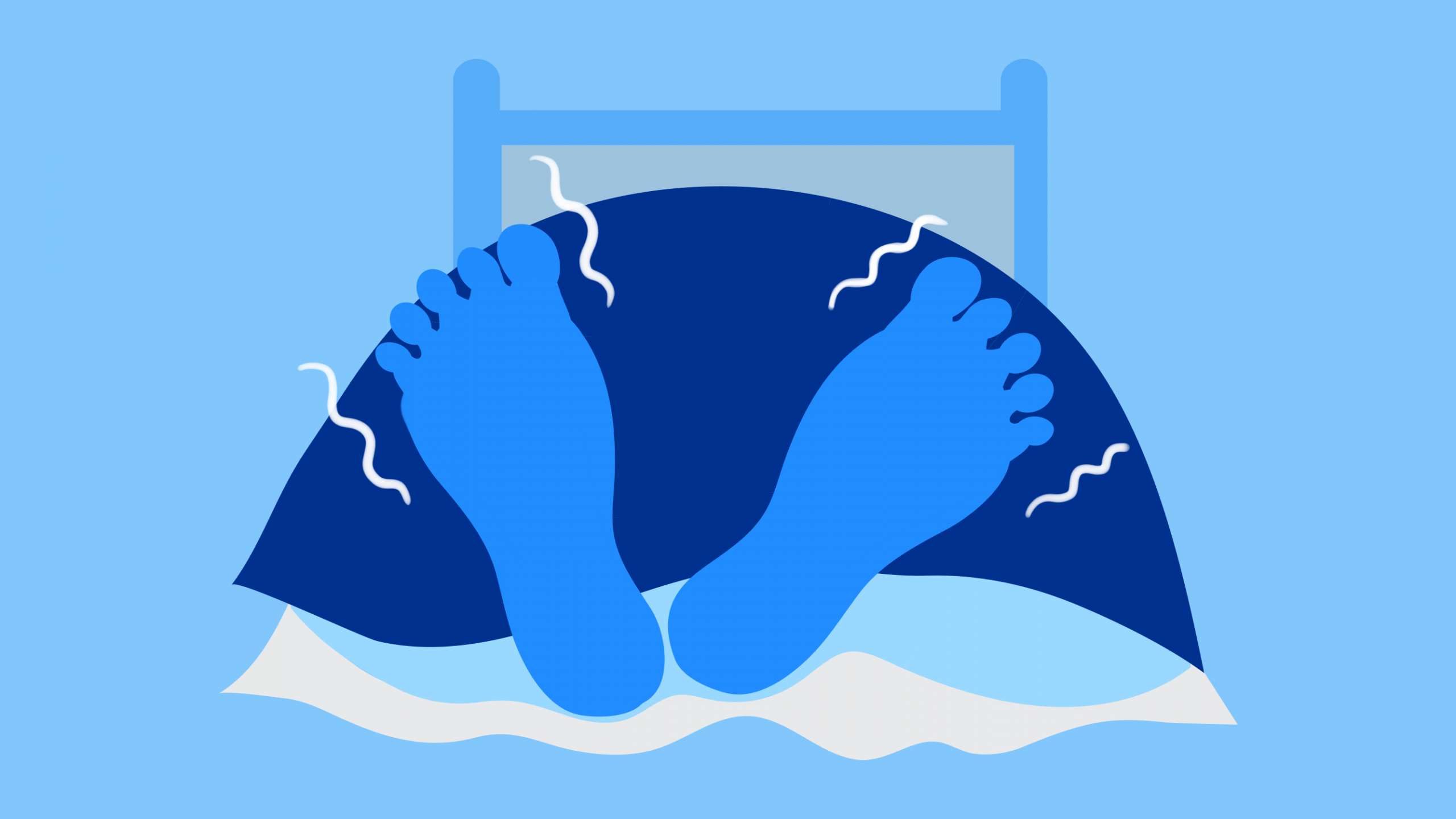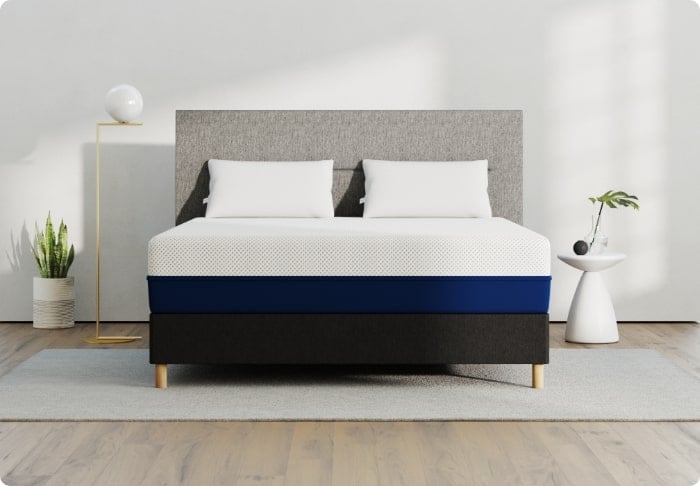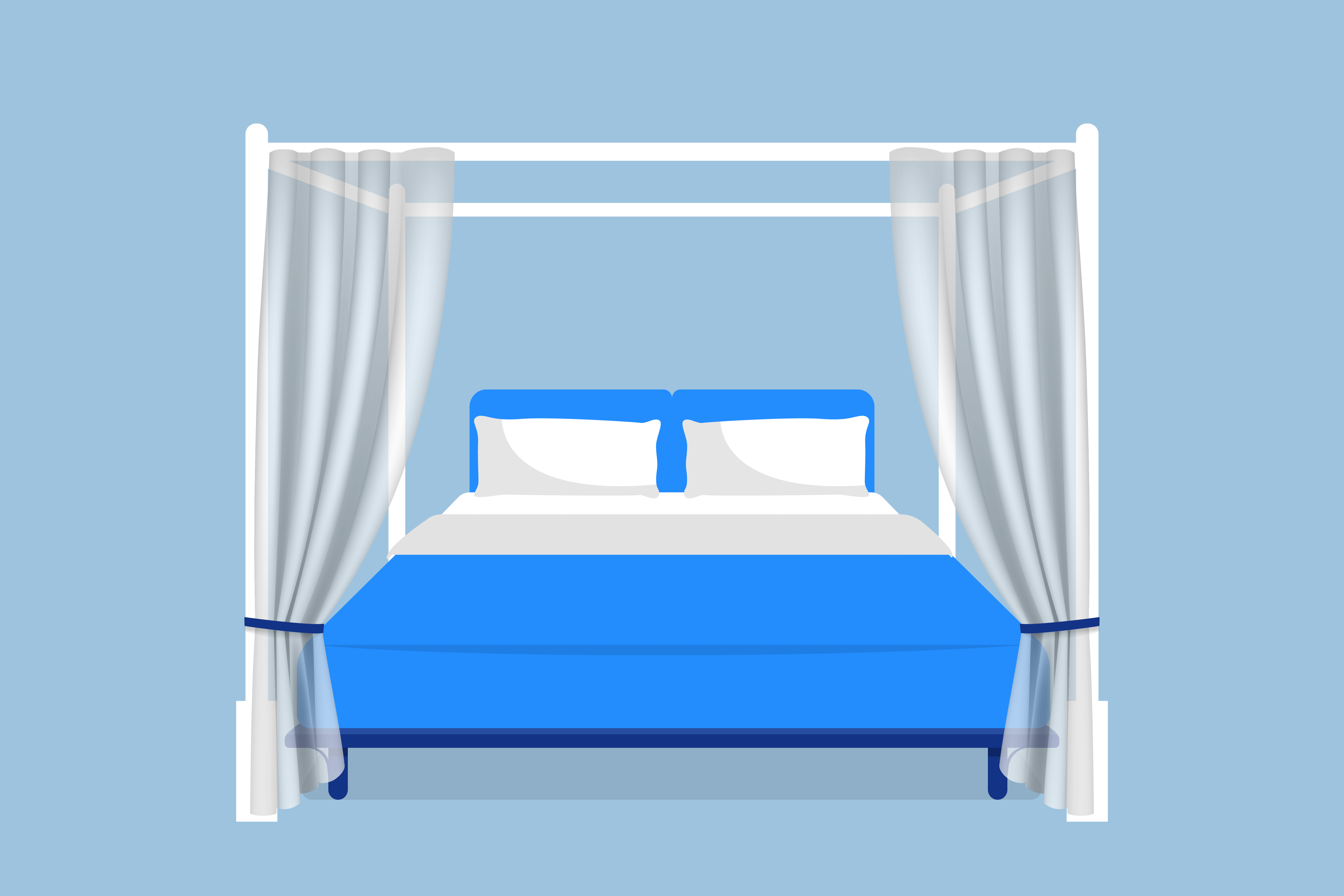Key Takeaways
- What Is RLS: Restless Legs Syndrome (RLS), also known as Willis-Ekbom Disease, is a nervous system disorder that causes an overwhelming urge to move the legs, particularly during periods of rest or inactivity. It affects a significant portion of the population and is more common in women and older individuals.
- Symptoms of RLS: RLS symptoms are characterized by sensations like creeping, crawling, pulling, itching, or tugging in the legs. These symptoms intensify at night, often leading to disrupted sleep, daytime fatigue, and a negative impact on daily life. The severity and frequency of symptoms can vary from person to person.
- Causes of RLS: The causes of RLS can be genetic, related to lifestyle factors, certain medical conditions, iron deficiency, or medication use. Diagnosis is based on specific criteria, and while there is no cure, the condition can be managed through medication, lifestyle changes, and alternative therapies.
Tossing and turning in bed, nagged by an irresistible urge to move your legs? You’re not alone! Welcome to our deep dive into Restless Legs Syndrome (RLS), a nerve-wracking, often misunderstood condition.
Discover why it occurs, its telltale signs, and treatment options—because peaceful nights should be everyone’s right.
What Is Restless Legs Syndrome?
Restless Legs Syndrome (RLS), Verified Source National Library of Medicine (NIH) World’s largest medical library, making biomedical data and information more accessible. View source also known as Willis-Ekbom Disease, is a nervous system disorder that triggers an overpowering urge to move your legs, particularly during periods of rest or inactivity.Symptoms often intensify during the evening or night, leading to disrupted sleep and, consequently, daytime fatigue. It affects roughly 7-10% of the U.S. population (with occurrences lower in Verified Source National Library of Medicine (NIH) World’s largest medical library, making biomedical data and information more accessible. View source Asia and Africa), women being more likely Verified Source National Library of Medicine (NIH) World’s largest medical library, making biomedical data and information more accessible. View source to suffer from it more than men. Data also suggests that its frequency of occurrence in the population increases with age.
RLS Verified Source National Library of Medicine (NIH) World’s largest medical library, making biomedical data and information more accessible. View source is seen in people of all ages, but the frequency and severity often increase with age. By understanding RLS better, we can bring greater awareness and offer solutions to those affected.Symptoms of Restless Legs Syndrome
Restless Legs Syndrome Verified Source National Library of Medicine (NIH) World’s largest medical library, making biomedical data and information more accessible. View source presents a unique constellation of symptoms, generally characterized by a compelling urge to move the legs. This is often associated with unpleasant sensations—primarily in the lower limbs—described as:- Creeping
- Crawling
- Pulling
- Itching
- Tugging
Interestingly, RLS symptoms aren’t constant throughout the day. They tend to be minimal or absent in the morning but intensify as the day progresses, peaking at night. This nightly exacerbation often results in sleep disruption, making restful nights elusive.
Symptoms of RLS can vary Verified Source National Library of Medicine (NIH) World’s largest medical library, making biomedical data and information more accessible. View source significantly from one person to another in terms of intensity, frequency, and the specific nature of the discomfort.
Some people might experience mild, sporadic discomfort, while others endure severe symptoms that significantly affect their quality of life. Understanding these variations is crucial for tailoring an effective treatment plan.
How Does Restless Legs Syndrome Affect Daily Life?
Restless Legs Syndrome (RLS) Verified Source National Library of Medicine (NIH) World’s largest medical library, making biomedical data and information more accessible. View source can significantly impact daily life, starting with sleep. The compelling need to move the legs often disrupts sleep, leading to insomnia and fatigue.Over time, chronic sleep deprivation can result Verified Source National Library of Medicine (NIH) World’s largest medical library, making biomedical data and information more accessible. View source in decreased productivity and impaired functioning in daily activities.
The disruption doesn't end Verified Source National Library of Medicine (NIH) World’s largest medical library, making biomedical data and information more accessible. View source with sleep. The discomfort caused by RLS can make sedentary activities like sitting for extended periods, traveling, attending meetings, or even enjoying a movie quite challenging, often impacting the overall quality of life.
RLS also takes a toll Verified Source National Library of Medicine (NIH) World’s largest medical library, making biomedical data and information more accessible. View source on mental health. Sleep disturbances and daily life challenges can contribute to stress, anxiety, and depression.
Some people with severe RLS might also experience social isolation due to the misunderstanding of their condition. Recognizing and addressing these impacts is a vital part of managing RLS.
Possible Causes of Restless Legs Syndrome
Restless Legs Syndrome (RLS) can be associated with a variety of factors:
- Genetic factors
- Lifestyle factors, such as caffeine consumption, lack of physical activity, sleep deprivation
- Medical conditions
- Iron deficiency
- Sleep disorders
- Periodic limb movement disorder
- Kidney failure
- Diabetes
- Peripheral neuropathy
- Parkinson’s disease
- Pregnancy
- Certain medications, such as anti-nausea drugs, antipsychotics, and certain antidepressants
While the exact cause of RLS remains unknown, these factors have been frequently observed in individuals with the condition. Genetic factors are especially prominent in cases where RLS begins at an early age, with specific gene variants associated with RLS suggesting a family link.
Lifestyle factors such as excessive caffeine consumption, lack of exercise, and sleep deprivation can exacerbate RLS symptoms.
Certain medical conditions, including iron deficiency, kidney failure, diabetes, peripheral neuropathy, and Parkinson’s disease, often coexist with RLS. Pregnancy Verified Source National Library of Medicine (NIH) World’s largest medical library, making biomedical data and information more accessible. View source can also trigger RLS symptoms, typically in the third trimester. However, it often clears up after an individual has given birth.
Furthermore, some medications, Verified Source National Library of Medicine (NIH) World’s largest medical library, making biomedical data and information more accessible. View source like anti-nausea drugs, antipsychotics, and certain antidepressants, may worsen RLS symptoms. Recognizing these potential causes is an important step in the early identification and effective management of RLS.
How Is Restless Legs Syndrome Diagnosed?
Diagnosing Restless Legs Syndrome involves a careful evaluation and elimination process, as there are no specific lab tests to confirm its presence. Here’s how the process usually goes:
Role of Medical History
The process begins with an in-depth discussion about your symptoms, including their severity, timing, triggers, and any relief methods you’ve found. Information about your sleep patterns, lifestyle habits, and any other underlying health conditions you may have will also be evaluated.
Necessary Tests and Examinations
While there are no definitive tests for RLS, certain medical tests may be necessary to rule out other conditions or identify potential contributing factors. These can include blood tests to check for iron deficiency or kidney problems or a sleep study to assess the impact of RLS on your sleep quality.
(See also Does Lack of Sleep Affect My Blood Test Results?)
Criteria for Diagnosis
The diagnosis of RLS Verified Source National Library of Medicine (NIH) World’s largest medical library, making biomedical data and information more accessible. View source is based on four primary criteria developed by Verified Source National Library of Medicine (NIH) World’s largest medical library, making biomedical data and information more accessible. View source the International Restless Legs Syndrome Study Group:
- An urge to move the legs, often accompanied by uncomfortable sensations.
- Symptoms begin or worsen during periods of rest or inactivity.
- Symptoms are partially or totally relieved by movement.
- Symptoms are worse or only occur at night.
Dr. Nayantara Santhi notes that the below are the augmented diagnostic criteria of IRLSSG:
- An increased overall intensity of the urge to move or sensation is temporally related to an increase in the daily medication dosage
- A decreased overall intensity of the urge to move or sensations is temporally related to a decrease in the daily medication dosage
- The latency to RLS symptoms at rest is shorter than the latency with an initial therapeutic response or before treatment was instituted
- The urge to move or sensations are extended to previously unaffected limbs or body parts
- The duration of the treatment effect is shorter than the duration with the initial therapeutic response
- Periodic limb movements while awake either occur for the first time or are worse than with the initial therapeutic response or before treatment was instituted
These steps help physicians make an accurate diagnosis and formulate an effective treatment plan for RLS.
“An interesting aspect is that there are conditions that cause uncomfortable nocturnal leg sensations such as nocturnal leg cramps, that are imitators of RLS,” says Dr. Santhi. “Some examples are painful peripheral neuropathy, myofascial pain syndromes and fibromyalgia, and motor akathisia. In fact, the exclusion of these RLS mimics (as they are known) is an official diagnostic 5th criterion for RLS.”
Treatments Available for Restless Legs Syndrome
Restless Legs Syndrome (RLS) can be effectively managed through a combination of treatments. These typically include:
- Medications: Several prescription medications Verified Source National Library of Medicine (NIH) World’s largest medical library, making biomedical data and information more accessible. View source are available to treat RLS, Verified Source National Library of Medicine (NIH) World’s largest medical library, making biomedical data and information more accessible. View source including dopamine agonists, calcium channel alpha-2-delta ligands (such as gabapentin and pregabalin), and opioids. The choice of medication will depend on the severity of symptoms, associated side effects, and potential interactions with other medications the person may be taking.
- Lifestyle Changes and Home Remedies: Lifestyle adjustments can significantly alleviate RLS symptoms. These adjustments Verified Source Medline Plus Online resource offered by the National Library of Medicine and part of the National Institutes of Health. View source can include regular physical activity, a healthy sleep routine, reduction or elimination of caffeine, quitting smoking, and maintaining a balanced diet. It’s also important to manage stress as it can aggravate RLS symptoms.
- Iron Supplements: If blood tests reveal low iron levels, an iron supplement may be recommended. Verified Source Harvard Health Blog run by Harvard Medical School offering in-depth guides to better health and articles on medical breakthroughs. View source Always consult with a healthcare professional before beginning any new supplement regimen.
- Alternative Treatments: Some people with RLS find relief through alternative methods like Verified Source National Library of Medicine (NIH) World’s largest medical library, making biomedical data and information more accessible. View source compression devices, massage, acupuncture, or biofeedback.
While these treatments can’t cure RLS, they can help control its symptoms, reduce nighttime awakenings, and improve sleep quality. It’s important to discuss these options with a healthcare provider to determine the most effective treatment plan for individual needs.
Can Restless Legs Syndrome Be Prevented?
Restless Legs Syndrome occurs in two forms: Verified Source National Library of Medicine (NIH) World’s largest medical library, making biomedical data and information more accessible. View source primary and secondary. While there’s currently no surefire way to completely prevent RLS, particularly primary RLS, which is genetically inherited, there are effective strategies to manage its symptoms and potential impact on your life.
Occasionally, people experience restless legs syndrome, which might worsen symptoms during certain periods. Key strategies for managing RLS, whether it’s primary or secondary, revolve around healthy lifestyle choices. Regular exercise, good sleep hygiene, and a balanced diet can significantly contribute to managing this sleep disorder.
Limiting the intake of caffeine also plays a critical role, as these can worsen symptoms. Symptoms occur predominantly at night, making it challenging to fall asleep, which is why good sleep hygiene is so crucial.
For those with secondary Restless Legs Syndrome, caused by underlying conditions like iron deficiency or kidney disease, appropriate management of these conditions can help keep RLS symptoms at bay. Ultimately, leading a healthy lifestyle can not only help in managing RLS but also prevent the escalation of symptoms, improving overall well-being.
FAQs
Can children suffer from Restless Legs Syndrome?
Yes, children can Verified Source National Library of Medicine (NIH) World’s largest medical library, making biomedical data and information more accessible. View source experience Restless Legs Syndrome (RLS). However, symptoms might be harder to identify as kids may describe their feelings differently. It’s important to consider RLS if a child has difficulty sleeping, shows signs of daytime fatigue, or reports uncomfortable sensations in their legs.
Are there any foods or drinks that can exacerbate RLS symptoms?
Yes, substances like caffeine and other stimulants can worsen Verified Source National Library of Medicine (NIH) World’s largest medical library, making biomedical data and information more accessible. View source RLS symptoms. Some people also report an increase in symptoms after consuming sugary foods. It’s advisable to monitor your diet to identify any potential triggers and discuss them with a healthcare provider.
Does exercise help or hurt Restless Legs Syndrome?
Moderate, regular exercise Verified Source National Library of Medicine (NIH) World’s largest medical library, making biomedical data and information more accessible. View source can help alleviate symptoms of RLS. However, extreme or strenuous exercise may exacerbate symptoms for some people. Experts recommend incorporating a balanced fitness routine, but remember that the results may vary from person to person. Always consult a healthcare provider before starting a new exercise regimen.
What helps restless leg syndrome when trying to sleep?
Several strategies can provide relief for restless leg syndrome when trying to sleep. Some effective methods include taking a warm bath before bedtime, practicing relaxation techniques like deep breathing, applying heat or cold packs to the affected areas, and maintaining a consistent sleep schedule. Additionally, avoiding caffeine and stimulants close to bedtime and creating a comfortable sleep environment can aid in managing symptoms.
What makes restless legs worse at night?
Restless legs syndrome symptoms often worsen at night due to various factors. Increased fatigue towards the end of the day can exacerbate symptoms, as can sitting or lying down for extended periods, especially in uncomfortable positions.
Stress and anxiety may also play a role in worsening symptoms at night. Also certain medications or medical conditions, like iron deficiency or kidney disease, can contribute to more severe restless leg syndrome symptoms during nighttime hours.
Conclusion
RLS symptoms can vary in intensity and frequency among individuals, and they can significantly impact daily life. The condition disrupts sleep, affects daily activities like sitting for extended periods, and can lead to stress, anxiety, and social isolation. While the exact cause of RLS is unclear, it can be associated with genetic factors, lifestyle habits, and certain medical conditions or medications.
Diagnosing RLS involves evaluating symptoms, medical history, and ruling out other conditions. There are no specific lab tests for RLS, but blood tests and sleep studies may be conducted. The diagnosis is based on four primary criteria related to the urge to move the legs and symptom patterns.
Managing RLS involves a combination of treatments, such as medications, lifestyle changes, iron supplements (if needed), and alternative therapies. While RLS cannot be fully prevented, a healthy lifestyle, including regular exercise, good sleep habits, a balanced diet, and limiting caffeine intake, can help manage symptoms and improve overall well-being.
About the author
April Mayer is a sleep expert and writer with a degree in exercise physiology. She has dedicated her career to exploring the relationship between sleep and productivity. Her insightful articles, such as "The Surprising Way Your Mood Might Be Messing With Your Productivity" and "Wake Up to More Productive Mornings," have been featured in reputable publications like Forbes, Greatist, Real Homes, Thrillist, Tom's Guide, and Eat This, Not That. With a passion for helping others lead more productive lives through restful sleep, April offers valuable expertise on foods and vitamins for better sleep. As a trusted member of the Early Bird team since March 2020, she continues to provide informative and well-researched content.
View all posts




